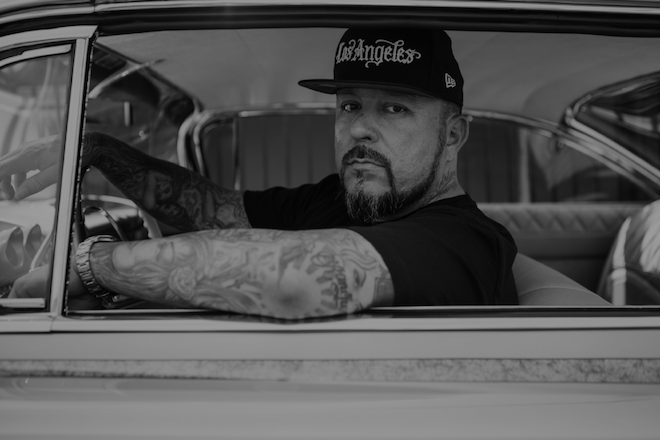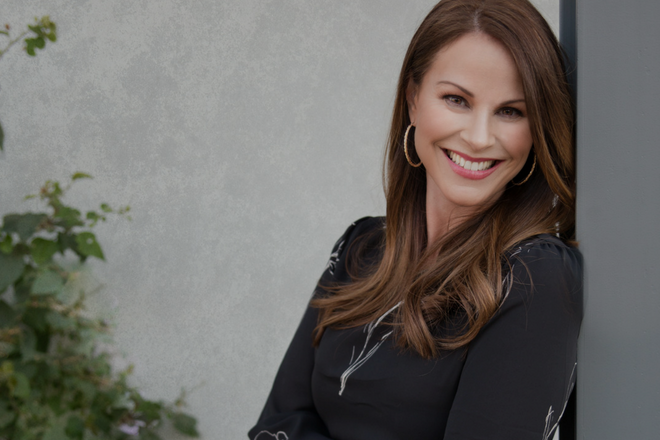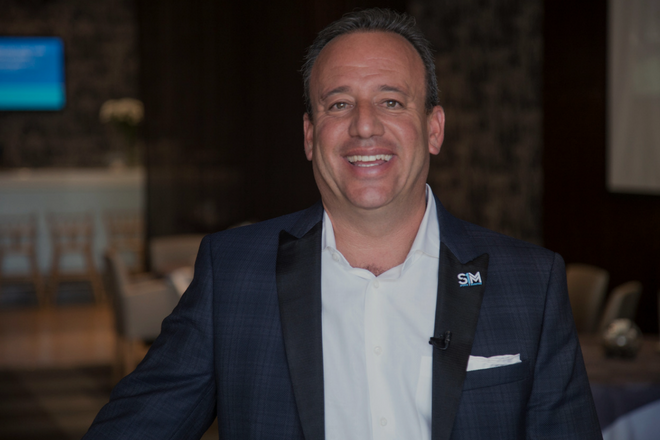“You’re always starting over again if you’re climbing. I’ve been doing that over the years, but I’m really stepping it up right now with a lot of things in my own life, but you always want to be better. You always want to improve yourself, and I think that just goes on forever.”
Mister Cartoon – Tattoo Artist, Entrepreneur, Serial Collaborator, Cultural Icon; Staying consistent & repetitive; Right mindset; Trust timing; Being clear; You’re always starting over.
Segment 1: (Length :04:00) – General Updates; Introduction to Mister Cartoon and his journey as an entrepreneur and artist; learning from the ground up; mirroring artists he admired; experimenting with art.
Cartoon’s finer points:
I was fortunate that my parents are artists. They're not professional artists, but both can draw, both of them have open minds.
“My father had a small print shop in the Harbor area of L.A., East side Terrence, and he grew up sweeping the floors of a printing shop and ended up having one of his own.”
“He would make lithograph posters, business cards, restaurant menus. So at a very young age I was around talented white paper. Even though it was a mom and pop shop, my mother would show me how professional artist would turn in their artwork.”
I never went to art school, but I was infatuated with art.
“So I would just draw whatever I was into. If I was into Karate, I would draw nothing but Karate and dragons. I was into BMX or once I started getting older I would just draw girls, you know. I really just did it. There was no big scheme of being famous or making money out of it.”
“It was more, I think, fitting in the early 80s when hip hop came in. You were a breaker, you were a DJ you were a graffiti rat. I stayed to the graffiti thing, so it was more about fitting in with my peers and having something to make my name known to impress girls walking to high school. That’s where it started, you know.”
“But, as time went on, the old man was like, ‘You gotta go get a job’. So I knew printing wasn’t my thing, lithography, so I started airbrushing t-shirts at the swap meet and car show.”
There were no street brands back then. I would airbrush you and your crew on the back of your shirt. I'd bring a jean jacket in, I'd put your neighborhood back there, you know. Then we started designing clothes without really knowing. We just did it.
“I didn’t know I was designing clothes until someone told me, so I went to Japan in 1992 and someone said, ‘Hey how long you been designing clothes?’ I was like, oh shit, I guess I am.”
“I just started drawing logos for people’s places. I went to a Barber shop and I’d seen they had a shitty logo I would … If I went to a barber shop and I’d seen that they had a shitty sign I would say, ‘Hey man, I can do a nice sign for you,’ and I would.”
“I would design the little logo for the business cards, take it to my old man, he’d print the business card, and that was really like the beginning of my designing and I still do it today..”
I think where I was fortunate was that I knew I wanted to be artist. At least I knew I wanted to be an artist. I didn't know I was going to be a graffiti artist or a tattoo artist cause I was interested in all of these different forms of art.
“I think knowing that I wanted to be an artist kept me on the same path at doing the same thing. Where I would see a lot of my friends bouncing all over the place. ‘I want to do this, I want to do that,’ at opposite ends of the spectrum, where as I would grow I would go into different forms of art.”
“When I was tired of airbrushing t-shirts at car shows and dealing with the crowd and all that, I got into silk screening design. Doing one design and mass producing them.”
You're always looking to improve yourself. I was looking how can I get better, and I would model myself after older guys that were doing it, and I would say how can I do it different.
“It was really about, in a way, at the beginning, mimicking older guys and their styles, and then I found my style just by practice and repetition.”
“That helped me a lot was watching and studying other people. They call it, now they call it mirroring. When you mirror someone, but the key is to have your own look and your own thought process behind it.”
Segment 2: (Length :08:00) – Talking with Mister Cartoon; Being consistent with his work; Working with brands and corporations; Having authority to create his way; Having good people around him.
Cartoon’s finer points:
I think my whole life is kind of like that where you try to find these little jewels in different places. I mixed my art style up by combining 1940s gold leaf and 1970s chollo style, gangster art. And I mixed in '80s New York, subway graffiti, and I kind of put it in a pot, and I like all of those things.
“I’m fortunate to be from an era where I’m heavily hip hop influenced. The guys that are older than me, maybe 5-10 years older than me, they missed hip hop. They don’t identify with hip hop.”
“That’s insane in itself, just thinking about creating the product that we do on a daily basis, and just putting our twist on it and our brand on it.”
I think the consistency part is you know, you can't be cutting corners or rushing it. You try to keep this certain level of quality very high because your peers are watching you. I don't cut corners ... Most people won't even know if you cut a corner, it's your peers that'll know so that's why we don't do it.
“It’s always a process working with corporate companies. Your job is to present them what’s real and what looks good, and what will attract the youth and keep their loyal customers.”
“You have to touch these different demographics and get different ages, and you have to please someone that is basically the bank, your client. You know what I’m saying? So sometimes I just flat out, turn them down.”
“If I look at and I go, ‘You know what? I don’t really use that brand or like that brand. I’m good,’ so I’ll just have to eat it and just pass on it respectfully. You don’t want to burn the bridge. That kind of mind may work on Jordan’s in a couple years so you don’t want to burn the bridge, but sometimes it does not fit, but sometimes it does.”
“You have to deal with other art directors, you’ve got to deal with different personalities. I’m fortunate that I have a very good team. I have a manager, I have a studio manager. I have people that I have built over the years to help me.”
I have all these different chess pieces. The thing is being able to have everything work and move together, but when I do deal with a client sometimes they like to do the creative so they need to step back and let me do the creative.
Segment 3: (Length :10:00) – Being repetitive in the process; Getting the right mindset; Trust the timing of things; Being clear on where you want to go; You’re always starting over.
Cartoon’s finer points:
I think that doing something repetitive, even with brain patterns, like even the way I talk to myself, I think that's one of the most dangerous areas we get into is how do we speak to ourselves. I have to be careful how I talk to myself.
“When I woke up today, either I can get motivated. I can be in a state of gratitude and be ready to smash, and be happy to do it or I can get frustrated and say, “Man, you know what? This work I got to do today is not in my lane. Fuck, why do I gotta work today?'”
“I can kind of talk myself into a negative state. I think as a human you always do that, but I work and I have a certain tools nowadays to kind of convince myself that this is my last day. This is it. This is the last piece I’m going to do. How is it going to look?”
“When I go into it with a state of this is my last day on Earth. I’m a little more hyped and motivated to get work done, repetitive work because it is that repetition that sharpens the sword. It’s little by little to keep sharpening it, keep sharpening it.”
I do think there are some invisible things I can't explain. There's certain timing on things that I've had. Not to go off and keep talking about religion, but many people told me in my life, 'You're gifted. You're blessed,' And I understand they were trying to be very complimentary to me, but I don't believe that I'm any of those things.
“I know artists that are technically can draw onion rings around me, and I know people that are much more successful that I can draw better than them. It’s not a drawing contest. Everyone can draw. If you look at Instagram, apparently, you can tell, everyone can draw. Everyone can rap, and everyone can design clothes. It’s having your own look on it.”
“I think that doing, having a clear visual picture of yourself of where you want to be is what made the difference in my career. Meaning, I can tell you crystal clear where I’m going to be at in 5 years. Not only can I tell you, but I can draw it for you and make you smell it. You know what I’m saying?”
“It doesn’t cost anything for you to dream. You kick back in your little lounge chair, you kick back at your kitchen table and visualize yourself in your dream position. What is that position?”
“I do a lot of stuff that I trip out on that I never thought I would do, but it’s still connected to art. Artistically and business wise I see myself in a certain position, certain amount of employees, employing other artists, surrounding myself in a think tank of creative people, positive people, and I’m already doing that now.”
You can start living the life that you want to be today, right now, by acting that it's already happened. You've got to pretend that your stuff's already popping so that you have to design in such a way. If you already believe you're successful and you're doing great, and you're a fortunate person, you're going to do better art.
“I can either go to war with 50 artists that are doing my style or I move onto the next look, and you just say, “Hey, now it’s standard issue. I can’t be mad that … I borrowed from other people when I was coming up.'”
“I looked at older guys, tried to mimic them, and now that’s what they’re doing to me. I have to, once again, shut my eyes and envision what would blow my mind if I’d seen walking down Fairfax and a guy walks up to me, asks me for a light, and he had a t-shirt on, what would I be blown away by seeing? Or I have to go obscure, man. I’ve got to go look at the different places and draw inspiration from obscure, weird places that most people aren’t doing.'”
“Pushing hard, everyday. It’s like, a lot of times artists are lazy. You know what I’m saying? We want to be successful but we don’t want to put in the work. It’s really just about working.”
Now, going back to that, there are some artists that I can't explain. They are phenomenal and amazing artists. I don't put myself in that category. I put myself more as a trade. I love this, but I treat it as a trade.
“We were ahead of the bend. We had a formula because I built myself after watching my friends in the music business. I would just test things out because I was mimicking my friends in the music business.”
“Now, I’m starting all over again basically in the film world. I’ve been in the film world since I was a kid I drew graffiti for the movie sets. When I was 16 I would go for a TV show, and it was like winning the lottery. They’d pay me to write my name on their walls, chollo writing and shit.”
“I was already doing that stuff for free, but I got infatuated with the film industry. I was on set, getting paid, and I never stopped. I’ve done storyboards. I’ve always been obsessed with the film business, but now I just executive produced my first feature movie with Imagine Entertainment and Bloom House.”
You're always starting over again if you're climbing. I've been doing that over the years, but I'm really stepping it up right now with a lot of things in my own life, but you always want to be better. You always want to improve yourself, and I think that just goes on forever.
“I heard that good deeds stack on top of each other so it’s successfully calling mom to tell her you love her, successfully calling someone back you don’t want to talk to. It’s successfully taking out the garbage with a smile. It’s successfully doing the mediocre things because they keep stacking on top of each other.”
“. . . and the same thing with failure. It’s failing to call that person back, it’s failing to follow through, it’s failing to pay that person that you borrowed money from. All these little failures end up leading to a big flop. I think it’s all the small successes throughout the day.”
“I know guys who are pure bullshit. I’m talking about 99% bullshit and 1% talent, and the ones that truly believe in themselves and push real, real, real hard, like offensive hard make it to the top. It’s unfortunate that it is that way, but it is that way.”
You can be cool, you can be a decent person, but you can't be nice all the time. You've got to fucking kick ass and take no prisoners. You've got to go like, you know what I'm going to hit them with this, I'm going to hit them with this. That didn't work out? Cool. I'm going to do this now. I'm going to do that. Seeing yourself in that position, seeing yourself doing it, surrounding yourself with a team of do-ers, a team of people that are on you.
“A lot of it is my team, man. I’m surrounded by talent, surrounded by people who want to push hard, and I stayed away from shady areas, shady situations, people that can get me twisted in bullshit.”
“I was told, say you won the lottery, what would you make? What would you make? What would you do? If money was no object what would you create? What would you add to your community? After you’re done buying cars and your mom a house, what would you make? You’ve got to make something.”
“Be clear on what you want. You think man I want money. No, you don’t. You want more money for the power, freedom, time, relaxation. You want more money. For instance, you already experience those things. Money does make things easier, but that’s not really what you want. You want to make things. You want to be a part of a crew that’s stepping up to the plate doing something. That’s what it comes down to. It’s constantly, constantly streamlining yourself to do better.”
Segment 4: (Length :03:00) – Hustler Thought of the Day:
It’s funny how impossible dreams manifest. - BReal (Cypress Hill)
GENERAL NOTES:
Mister Cartoon – Tattoo Artist, Entrepreneur, Serial Collaborator, Cultural Icon
- Born and raised in Los Angeles, Mister Cartoon’s expressive style of art is universally recognized and embodies the true soul of Los Angeles street culture. Beginning his career as a graffiti artist in the 1980’s, he gained notoriety for his album cover designs, logos, advertisements, custom lowrider car murals and his one of a kind tattoos.
-
Mister Cartoon’s richly detailed, hand-rendered designs are inspired by the style of tattoos that originated in the streets of 1970s’ Los Angeles – fine line Chicano black and grey custom tattoo art.
- Mister Cartoon took this style of tattooing and brought it into mainstream culture, he is known as a pioneer in the tattoo world as one of the first artists to get global notoriety by tattooing celebrities, athletes, musicians, and actors alike.
- His tattoos have been commissioned by many icons of the music and film industry from Dr Dre, 50 Cent, Snoop Dogg, Skylar Grey, Christina Aguilera, Eminem, Justin Timberlake, Justin Bieber, Shia Labeouf, Pharrell, Ryan Phillippe, Usher, Kanye west, YG, Nas, to DJ Premier and Slash).
- His work also adorns professional athletes such as CC Sabathia, Amare Stoudemire, Lewis Hamilton, Kobe Bryant, Jonathan Quick, Carlos Boozer, Matt Barnes, Paul Rodriguez, Carl Crawford, Terry Kennedy, and has come to represent strength, faith, and ferocity on the competition field.
- Cartoon’s private tattoo studio, Skid Row Tattoo itself has become a cultural landmark all in itself. From Thailand to New York, Japan and the United Kingdom, Cartoon’s tattoo residencies continue to take his cultural message worldwide.
- Mister Cartoon has partnered with companies such as Microsoft, Nike, Vans, Levis, Supreme, RVCA, Diesel, T-Mobile, Axe, Target, Universal Pictures and Fox Studios on a variety of successful collaborations, and now with Nike and Cazadores.
- He has been featured in numerous publications, including The New York Times, The Wall St Journal, Rolling Stone, Complex, XXL, GQ and many more.
- His work has been a integral part of music culture, producing album art work Logos and identities for the likes of Shady Records, Eazy-E, Paul Wall, Clipse, Cypress Hill, Wale, Zac Brown Band and many more.
- Cartoons custom muralled car collection and artwork has been featured internationally from art shows in London and Japan to the Los Angeles Museum of Contemporary Art and he’s continually driven to give back to the community that has supported him. He is able to do this through you outreach programs and collaborations with organizations that are active in the community.
###








